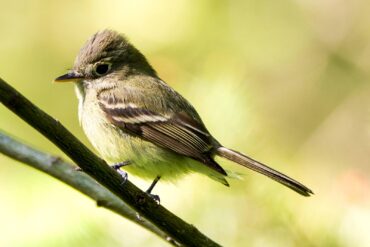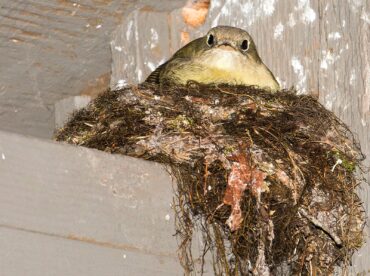
Birders measure the arrival of spring not by a date on the calendar, but by the sounds of birds returning from winter warmth in the South. From March to May, over two dozen species of migrant songbirds arrive for breeding in West Sound. To the delight of many, they fill the mornings with an array of melodies and chirps, indicating that spring has come.
In addition to year-round residents such as chickadees, wrens and nuthatches, migratory swallows, warblers, flycatchers and many others spend the spring months finding a mate, searching for the perfect nest site and raising a family. By summer’s end, they are ready to hit the flyway to begin the cycle anew.
Songbirds are often heard before being seen. They can be concealed from view; many prefer to stay tucked in trees and shrubs, as they noisily give away their approximate location. Among these are the tyrant flycatchers of North, Central and South America.
Having 400 species, “tyrant” flycatchers (named for the aggressive nature of flycatchers called “kingbirds”) comprise the largest family of birds in the world. Five of them regularly breed in West Sound: Pacific-slope flycatcher, Hammond’s flycatcher, olive-sided flycatcher, western wood-pewee and willow flycatcher, which typically arrive in that order.
With similar appearances, these flycatchers are best differentiated by habitat and sound. Fortunately for birders, flycatchers are very vocal. Having distinct calls, the five local breeders are fairly easy to identify.

Arriving by late April, the most common tyrant flycatcher of West Sound is the Pacific-slope flycatcher, which breeds in West Coast forests, from southern Alaska to southern California. It winters along the Pacific Coast of Mexico.
The Pacific-slope flycatcher inhabits mature deciduous, coniferous and mixed forests. It’s most often found in shady, moist forests near streams.
Formerly known as “western flycatcher,” the Pacific-slope flycatcher and Cordilleran flycatcher (a resident of the Rocky Mountains and the Southwest) were split by ornithologists in 1989 after genetic differences confirmed them as separate species.
Flycatchers are named for their preferred foraging style. The term “flycatching” (also called hawking) refers to the method of leaving a perch to catch a flying insect in the bill, then returning to the same perch, or sometimes a different one, to wait for the next passing victim. The Pacific-slope flycatcher employs this tactic and also gleans insects from tree branches. It consumes some seeds and berries too.
The Pacific-slope flycatcher is small, about the size of a black-capped chickadee. Its olive-brown upperparts, pale yellow underparts and white wingbars are similar to many tyrant flycatchers. An easy way to visually distinguish the Pacific-slope from other flycatchers is to take notice of its prominent white eye ring. The identification process is much simpler when the bird is singing.
The Pacific-slope flycatcher is heard more often than it is seen. It spends most of its time in mature trees in the middle forest canopy, where its trademark whistles reveal its presence. The typical call sounds like “fee-a-weet,” much like a person whistling for a dog. A single whistle can even resound through the forest in the middle of the night. Other vocalizations include a series of short, metallic tweets.
A bare tree branch doesn’t provide a sufficient nest site for a Pacific-slope flycatcher, which prefers a sturdy base with a shelter. Tree cavities, ledges on embankments and tree forks are ideal. Man-made structures, such as under the eaves of a house or garage, can provide additional options.
The female constructs the nest cup, made of moss, grass, bark and lichen, in less than a week. She incubates a clutch of three or four eggs for two weeks. Both parents care for the young, which leave the nest after another fortnight.
Following several days of hopping around in branches, the fledglings start to take flight. Two weeks after leaving the nest, the young begin to master the skill of flycatching and can fend for themselves.
Like all migrant songbirds, the immature Pacific-slope flycatcher must grow up quickly. By September, it heads south on its own to overwinter in the coastal lowlands of Mexico. By winter’s end, it will head north to its breeding grounds — perhaps here in West Sound — where it will raise a family of its own.
Along with other songbirds, Pacific-slope flycatchers are under constant threat from habitat loss and pesticide use. Populations are reasonably stable, but healthy forests, free of chemicals, are essential for providing nesting sites and insects for sustenance.
A walk in the woods provides a delightful escape from the busy world around us. With their vast range of pleasant melodies, songbirds offer a respite from stress. The Pacific-slope flycatcher arrives here after a long journey and stays but a short while each year. When it whistles, it’s as if nature is sending its greeting.



























